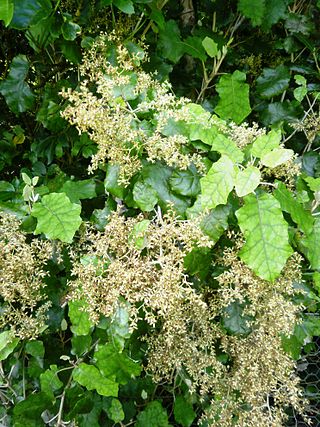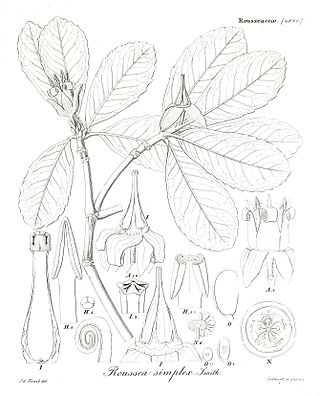
A pollinator is an animal that moves pollen from the male anther of a flower to the female stigma of a flower. This helps to bring about fertilization of the ovules in the flower by the male gametes from the pollen grains.

An aril, also called an arillus, is a specialized outgrowth from a seed that partly or completely covers the seed. An arillode or false aril is sometimes distinguished: whereas an aril grows from the attachment point of the seed to the ovary, an arillode forms from a different point on the seed coat. The term "aril" is sometimes applied to any fleshy appendage of the seed in flowering plants, such as the mace of the nutmeg seed. Arils and arillodes are often edible enticements that encourage animals to transport the seed, thereby assisting in seed dispersal. Pseudarils are aril-like structures commonly found on the pyrenes of Burseraceae species that develop from the mesocarp of the ovary. The fleshy, edible pericarp splits neatly in two halves, then falling away or being eaten to reveal a brightly coloured pseudaril around the black seed.

Alectryon excelsus, commonly known as tītoki, or sometimes New Zealand oak, is a shiny-leaved tree native to New Zealand. It is in the family Sapindaceae. It lives in coastal and lowland forests throughout most of the North Island and from Banks Peninsula to central Westland in the South Island.

Coprosma robusta, commonly known as karamū, is a flowering plant in the family Rubiaceae that is endemic to New Zealand. It can survive in many climates, but is most commonly found in coastal areas, lowland forests, or shrublands. Karamū can grow to be around 6 meters tall, and grow leaves up to 12 centimeters long. Karamū is used for a variety of purposes in human culture. The fruit that karamū produces can be eaten, and the shoots of karamū are sometimes used for medical purposes.

Vitex lucens, or pūriri, is an evergreen tree endemic to New Zealand.

Karaka or New Zealand laurel is an evergreen tree of the family Corynocarpaceae endemic to New Zealand. It is common throughout the North and South Islands to Banks Peninsula (43°45′S) and Ōkārito (43°20′S), on the Three Kings Islands, on Raoul Island in the Kermadecs, and on the Chatham Islands. It is widespread in coastal habitats, often forming a major component of coastal forest, though it rarely dominates. Most botanists consider it to be native only to the northern half of the North Island, having been planted elsewhere by Māori near former village sites, and subsequently spread by birds. The common name karaka comes from the Māori language, and is also the Māori term for the colour orange, from the colour of the fruit. In the Chatham Islands, it is called kōpī, its name in the Moriori language. It is naturalised and considered invasive in Hawaii.

Paeonia brownii is a low to medium height, herbaceous perennial flowering plant in the family Paeoniaceae. It has compound, steely-gray, somewhat fleshy leaves and small drooping maroon flowers. Its vernacular name is Brown's peony, native peony or western peony. It is native to the western United States and usually grows at altitude, often as undergrowth in part-shade. The fleshy roots store food to carry the plant through the dry summers and produce new leaves and flowers the following spring.

A flower, also known as a bloom or blossom, is the reproductive structure found in flowering plants. Flowers consist of a combination of vegetative organs – sepals that enclose and protect the developing flower, petals that attract pollinators, and reproductive organs that produce gametophytes, which in flowering plants produce gametes. The male gametophytes, which produce sperm, are enclosed within pollen grains produced in the anthers. The female gametophytes are contained within the ovules produced in the carpels.

Pterophylla racemosa, known as the kāmahi, is an evergreen tree native to New Zealand. It is part of the Pterophylla genus which mostly includes sub-tropical species, but the kāmahi is found in a variety of New Zealand climates from coastal areas to high-elevation inland areas.

Chamaecrista fasciculata, the partridge pea, is a species of legume native to most of the eastern United States. It is an annual which grows to approximately 0.5 meters tall. It has bright yellow flowers from early summer until first frost, with flowers through the entire flowering season if rainfall is sufficient.

Cuttsia viburnea is a shrub or bushy tree which has toothed leaves and panicles of white flowers, and that is endemic to eastern Australia. It is sometimes called silver-leaved cuttsia, and confusingly also native elderberry, honey bush or native hydrangea. C. viburnea is the only species assigned to the genus Cuttsia.

Leucopogon parviflorus, commonly known as coast beard-heath or native currant, is a shrub or small tree in the family Ericaceae. It is native to all Australian states and territories excluding the Northern Territory and the ACT and also grows in New Zealand. The species can grow to between 1 and 5 metres in height and has leaves that are 11 to 29 mm long and 2.4 to 7.5 mm in width, often with curved tips. The white flowers are around 15 mm long and are produced in spikes of 7 to 13. These occur throughout the year.

Brachyglottis repanda, the rangiora or bushman's friend, is a small, bushy tree or tall shrub endemic to New Zealand. It grows to a height of 5 to 7 meters. The petioles of the leaves have a characteristic groove up to 10 cm long. The large leaves with a soft furry underside have been referred to as "bushman's toilet paper".

Carpodetus serratus is an evergreen tree with small ovate or round, mottled leaves with a toothy margin, and young twigs grow zig-zag, and fragrant white flowers in 5 cm panicles and later black chewy berries. It is an endemic of New Zealand. Its most common name is putaputāwētā which means many wētā emerge - referring to the nocturnal Orthoptera that live in holes in the trunk of this tree made by Pūriri moth caterpillars. Regional variations on the name also refer to this insect that lives and feeds on it such as kaiwētā, and punawētā. The tree is also sometimes called marbleleaf. It is found in broadleaf forest in both North, South and Stewart Islands. It flowers between November and March, and fruits are ripe from January to February.

Strasburgeriaceae is a small family of flowering plants in the order Crossosomatales, only found in New Zealand and New Caledonia. It contains two genera, Strasburgeria and Ixerba. Both genera have simple, evergreen, alternated leaves, often in worl-like clusters, with gland-tipped serrations, hermaphroditic, pentamerous flowers with persistent sepals, clawed petals, flat and long filaments that extend beyond the petals and a persistent style with a punctiform stigma.

Roussea simplex is a woody climber of 4–6 m high, that is endemic to the mountain forest of Mauritius. It is the only species of the genus Roussea, which is assigned to the family Rousseaceae. It has opposing, entire, obovate, green leaves, with modest teeth towards the tip and mostly pentamerous, drooping flowers with yellowish recurved tepals, and a purse-shaped orange corolla with strongly recurved narrowly triangular lobes.

Brexia is a plant genus assigned to the Celastraceae. It is a dense evergreen shrub or small tree of usually around 5 m high, with alternately set, simple, leathery leaves with a short leaf stem and lanceolate to inverted egg-shaped leaf blades. The pentamerous flowers occur in cymes. The petals are greenish white, the stamens are alternating with wide, incised staminodes. The superior ovary develops in a long-ribbed fruit. Brexia naturally grows on the coast of East Africa, on Madagascar, the Comoros and Seychelles. Opinions differ about the number of species in Brexia. Sometimes the genus is regarded monotypic, B. madagascariensis being a species with a large variability, but other authors distinguish as many as twelve species. Common names for B. madagascariensis include jobiapototra, tsimiranjana, tsivavena, vahilava, voalava, voankatanana, voantalanina, voatalanina and votalanina, and mfukufuku (Swahili), mfurugudu and bwa kato (Seychelles).

Strasburgeria robusta is an evergreen tree with large toothed leaves and large but rather inconspicuous, single, pendulant flowers in a gloomy colorscheme of yellowish with brown markings, with about ten sepals, five petals, ten stamens, a very distinct circular nectar gland with radiating spikes and rather large globular fruits with a long persistent style, with a scent reminiscent of apples, which is endemic to New Caledonia. It is the only recognized species of the genus Strasburgeria.

Veronica strictissima, the Banks Peninsula hebe, is a species of flowering plant in the family Plantaginaceae. It is only found on Banks Peninsula in New Zealand.

Leucospermum formosum is a large upright shrub of up to 3 m (9.8 ft) high, from the family Proteaceae. It grows from a single trunk and its branches are greyish felty. The softly felty leaves are lance-shaped to elliptic, 6+1⁄2–10 cm (2.6–3.9 in) long and 14–20 mm (0.55–0.79 in) wide. The flower heads are flattened and about 15 cm (5.9 in) across, and consist of bright yellow flowers from which long, styles emerge which are strongly clockwise bent just below the white, later pink thickened tip. From above, the heads look like turning wheels. It is called silver-leaf wheel-pincushion in English. It flowers during September and October. It is an endemic species of the Western Cape province of South Africa.





















